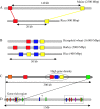Comparative genomics in the grass family: molecular characterization of grass genome structure and evolution
- PMID: 12096816
- PMCID: PMC4233775
- DOI: 10.1093/aob/mcf008
Comparative genomics in the grass family: molecular characterization of grass genome structure and evolution
Abstract
The genomes of grasses are very different in terms of size, ploidy level and chromosome number. Despite these significant differences, it was found by comparative mapping that the linear order (colinearity) of genetic markers and genes is very well conserved between different grass genomes. The potential of such conservation has been exploited in several directions, e.g. in defining rice as a model genome for grasses and in designing better strategies for positional cloning in large genomes. Recently, the development of large insert libraries in species such as maize, rice, barley and diploid wheat has allowed the study of large stretches of DNA sequence and has provided insight into gene organization in grasses. It was found that genes are not distributed randomly along the chromosomes and that there are clusters of high gene density in species with large genomes. Comparative analysis performed at the DNA sequence level has demonstrated that colinearity between the grass genomes is retained at the molecular level (microcolinearity) in most cases. However, detailed analysis has also revealed a number of exceptions to microcolinearity, which have given insight into mechanisms that are involved in grass-genome evolution. In some cases, the use of rice as a model to support gene isolation from other grass genomes will be complicated by local rearrangements. In this Botanical Briefing, we present recent progress and future prospects of comparative genomics in grasses.
Figures




References
-
- Asnaghi C, Paulet F, Kaye C, Grivet L, Deu M, Glaszmann JC, D’Hont A.2000. Application of synteny across Poaceae to determine the map location of a sugarcane rust resistance gene. Theoretical and Applied Genetics 101: 962–969.
-
- Avramova Z, Tikhonov A, SanMiguel P, Jin YK, Liu C, Woo SS, Wing R, Bennetzen JL.1996. Gene identification in a complex chromosomal continuum by local genomic cross‐referencing. Plant Journal 10: 1163–1168. - PubMed
-
- Bennetzen JL 1996. The contribution of retroelements to plant genome organization, function and evolution. Trends in Microbiology 4: 347–353. - PubMed
-
- Bennetzen JL 2000b Transposable elements contributions to plant gene and genome evolution. Plant Molecular Biology 42: 251–269. - PubMed
Publication types
MeSH terms
LinkOut - more resources
Full Text Sources
Other Literature Sources

